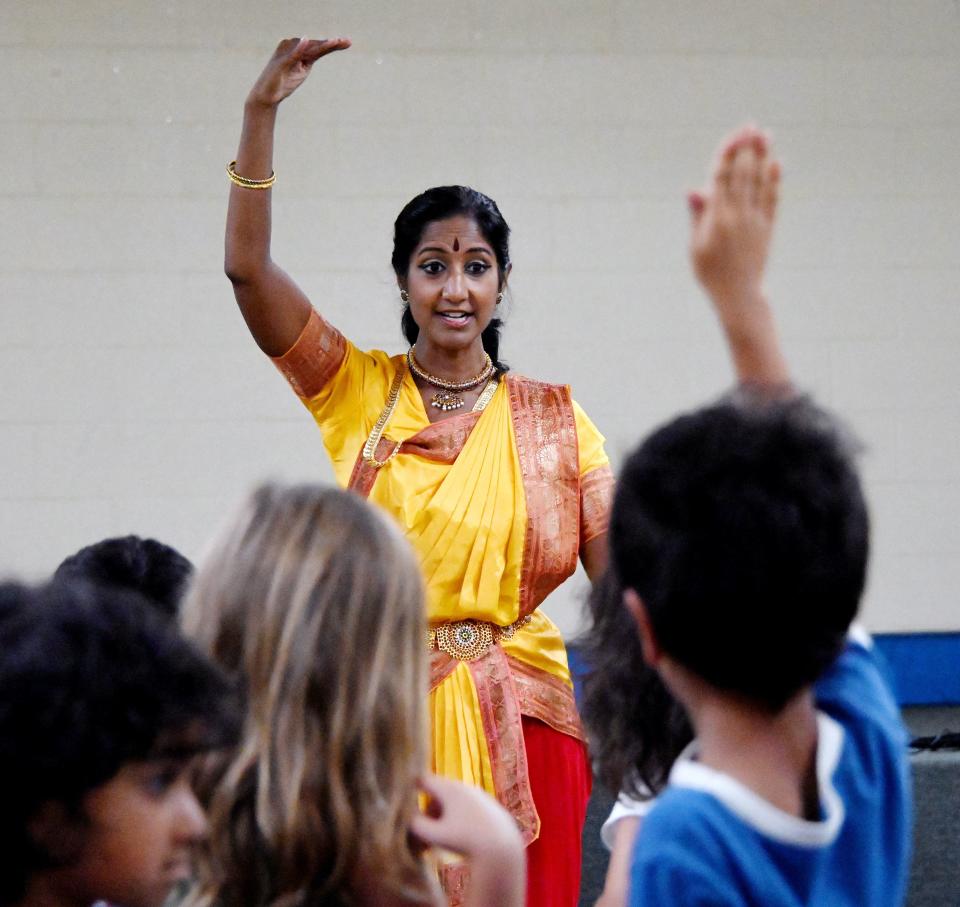Praneetha Akula uses classical Indian dance to bring the joy of learning to Maryland students
At Children’s Manor Montessori School in Germantown where Praneetha Akula was teaching and performing, a little girl got to see herself in her teacher.
The pre-K student announced that she knew how to dance kathak, one of the major forms of classical Indian dance that comes from northern India. She showed some of the movements to the children in her class.
Akula said it was one of the instances where she’s seen “immense joy” in the eyes of students who are excited to see an Indian-American woman teach them dance. Akula starts each of her performances by asking the kids if they have parents who come from other countries or speak other languages.
“It just helps other children, and adults even, share their heritage or their voice,” Akula said.
Akula is a dance teacher and teaching artist with Story Tapestries, an arts service organization that works with schools, community centers, libraries and mental health institutions to boost access to art. Arianna Ross started Story in 2010 and the organization puts on programs throughout Maryland, including in Baltimore City and County.
“No child, no adult should be without something they need,” Ross said. “I know some people might not think what we offer is what people need. But I saw during COVID how that was inaccurate. The opportunity to express yourself, to tell your story, to deal with your emotions, is critical, and the arts really provide that.”
Akula, 46, started with Story Tapestries in 2022, but she’s been dancing since she was three. She owns her own school in Silver Spring, Aikyam Selva Natanam, which translates to “dance through community.” Akula named the school after her late mother, Selvalakshmi Setty, her first dance guru.
Akula grew up in Winston-Salem, North Carolina. She majored in Spanish at Wake Forest University and has a master’s in teaching English as a second language from American University. She moved to Maryland in 2008 and worked as an elementary school teacher for over a decade.
Akula now teaches Bharatanatyam, which she said is one of the most ancient dance forms in India. It involves hand gestures, facial expressions and full body movement.
“It’s been in the past used to depict Hindu mythology, mythological stories, and just for pure movement as well,” Akula said. “But when I teach it, both with Story Tapestries and with my own dance school, I emphasize and use it as a vehicle to show children and adults that we can use this type of dance form to depict stories that relate to the world now.”
Akula ties in Hindu elements to her performances, such as the use of a puppet named for the elephant-headed deity Ganesha.
“This is kind of how I bring in a social-emotional aspect into my lessons, is I tell them that Ganesha is there to help me prosper,” Akula said. “When I have an obstacle that I’m trying to face, Ganesha helps me remove the obstacle by breathing and calming down.”
Akula makes her performances a collaborative process by asking the audience for input on how they think characters should move. Together, they set the story dance to music and she shows them how to do hand gestures or position their bodies. At the end of the workshop, Akula and the students perform the dance.
“They get a full snapshot of what Indian dance entails and what its purpose is,” Akula said. “I hope they enjoy it and see that Indian dance is an effective way to understand literature or you know, understand rhythm and in turn, math and reading.”
Valerie Baugh-Schlossberg, the program director for Story Tapestries, said Akula’s performances expose students to something new, giving them an energizing experience they can connect to real world concepts while expanding their imaginations.
“We are providing an opportunity to give students the permission, the structure and the opportunity to think in a way that doesn’t require [them] to sit in front of a screen and just take in information,” Baugh-Schlossberg said, “but to have that kinesthetic experience of doing in order to learn.”
Kohinoor Rauf, a teacher at Baltimore Children’s Manor Montessori where Akula performed, got to participate by playing the tabla, a pair of Indian hand drums, while Akula danced.
“She engages children very well,” Rauf, who is from Bangladesh, said.
Akula said it was exciting for the kids to see Rauf knew Indian dance and could help them see how the rhythm and beat flow together. It’s not something Akula saw often attending school in Winston-Salem. Though Akula had a supportive surrounding Indian community, she said the area wasn’t diverse. Akula was the only person she knew in school who danced Bharatanatyam.
Now, Akula is expanding Bharatanatyam’s reach. She recently performed at the World Culture Festival on the National Mall and she’ll dance on the Kennedy Center’s Millennium Stage Nov. 11 for a production called “Jhankaar” that showcases different classical Indian dance styles to celebrate Diwali.
Ross said Akula’s performances make you want to “lean forward” as you watch her dance.
“Sometimes people [think] art feels inaccessible, it feels sort of like above someone, it feels sometimes privileged,” Ross said. “She really doesn’t do that. She brings it to your level.”
This article is part of our Newsmaker series, which profiles notable people in the Baltimore region who are having an impact in our diverse communities. If you’d like to suggest someone who should be profiled, please send their name and a short description of what they are doing to make a difference to: Diversity, Equity, and Inclusion Editor Kamau High at khigh@baltsun.com.


